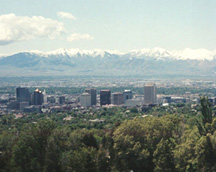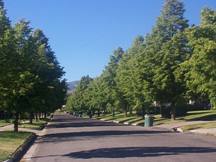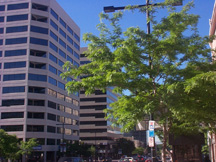The Urban Forest and Water Conservation
Trees are an important part of the water and energy conservation strategy.
May 24, 2001
William Rutherford, Salt Lake City Forester
|
|
An issue of immense importance related to planning, development and stewardship of green space is availability and conservation of water. Protecting water is not only sensible – it’s essential. However, we must also understand, protect and propagate elements of the ecosystem to which watersheds are linked and upon which they depend. Trees are such an element -- favorably affecting hydrological processes and water quality in many ways.
Trees facilitate more rapid absorption and capture of water in the soil. Where trees grow only 4% of annual precipitation is lost to surface runoff. In contrast, soils without trees absorb and capture less total volume of water and lose nearly 35% to surface runoff.
Effectiveness of reducing runoff and increasing infiltration are influenced by soil properties, topography, kind and duration of precipitation and plant cover. In the tree phylum, conifers generally do a better job in this regard than broadleaf deciduous trees.
According to the United States Department of Agriculture the nation loses more than 5 billion tons of soil annually to erosion. Scientists determined the problem is more severe in developed urban areas than on forested land. The absence or removal of trees is a major factor. The result is sedimentation of waterways, degradation of water quality and reduction of watershed storage capacity.
In addition to protecting water availability and quality, trees can offset the demand for irrigation of urban landscapes. A case in point is turf grass -- water consumption of turf can be reduced by 20% where covered by shade trees.
Shade from mature trees does far more than reduce water demand of landscape plants. Recently NASA completed an evaluation of Salt Lake City’s heat profile. One of the reports most prominent recommendations was to plant more trees. The benefits from doing so are not limited to cooler and cleaner air, but have a direct bearing on water conservancy as well.
Air temperature near soil surfaces that are not sheltered by trees can be 20 to 30 degrees Fahrenheit warmer than the surrounding air. This not only increases soil temperature and reduces moisture content, but also impedes recovery from drying out and reduces viability of the soil to support plant material.
|
|
Covered by trees, heat absorption by the soil is reduced. The results are more stable soil moisture levels, less extreme air temperature and moderation of heat related air pollution such as low level ozone. In addition, where soil temperature is cooler than surrounding air temperature water vapor contained in the air can penetrate the soil condense, and be conserved.
There is no question trees use water. A more important question would seem to be do we stop planting trees for this reason or do we recognize the invaluable contributions trees make to water conservancy and to the health and well being of our city’s environment.
Water usage can be controlled by wise species selection, improved planting practices and careful irrigation methods and schedules. Benefits lost by not planting trees in our neighborhoods would not be so easily addressed.
|
|
Suggestions for care of newly planted trees:
- Place water hose emitter on the surface of the root ball but not directly beside the trunk. Adjust water output to very low. There should be no water loss to runoff. Water once per week in the spring and no more than twice per week in the summer. Watering time should not exceed twenty minutes.
- Keep turf as far removed from the stem of the trees as landscape use allows. A 3 to 4 inch layer of bark mulch spread over the surface of the root ball is recommend as replacement for turf. Mulch should not make contact with the trunk.
- Contrary to popular opinion, most newly planted trees do not require soil fertilization or extensive pruning when planted.
- Use caution whenever applying herbicides. Young and old trees alike can be damaged or killed by unintended exposure to chemicals.
- Avoid attaching wires, screws, nails and other object to trees.
For more information please contact Salt Lake City’s Urban Forestry Division at 972-7818 or www.slcclassic.com/Departments/forestry


